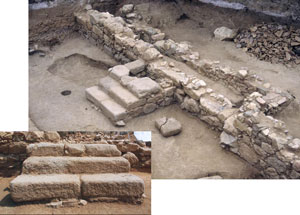 In 2003, new excavations in the area known as Can Masriera,
situated on the eastern side of the Cabrera de Mar stream
in front of the La Guardiola district, documented
structures that were heavily damaged. They have been
interpreted by the excavators as the possible remains of a
temple.
In 2003, new excavations in the area known as Can Masriera,
situated on the eastern side of the Cabrera de Mar stream
in front of the La Guardiola district, documented
structures that were heavily damaged. They have been
interpreted by the excavators as the possible remains of a
temple.
A preliminary study of the ceramic materials recovered during the excavations shows that the architectural remains are contemporary with those of Ca l’Arnau-Can Mateu and Can Benet. This has not only increased the known area of this important late Republican settlement, but has also shown that its eastern margin extended over both sides of the Cabrera de Mar stream. A recent study of the settlement considers the possibility that the remains are those of a small provincial temple with marked Italic influences: tegulae, imbrices, mortar coatings, the use of opus signinum, and possibly an in antis plan. The temple, from the third phase of the occupation of the site, may have been begun in the last quarter of the 2nd c. B.C.E., and was abandoned at the end of the first quarter of the 1st c. B.C.E., quite possibly in the decade of 80/70 B.C.E., in light of the abundant locally produced Dressel 1C amphorae that were recovered during the excavation.
The content displayed on this page reproduces, with permission of the author and the journal, fragments of the following article: Sinner, A. G. “Cultural contacts and identity construction: a colonial context in NE Spain (2nd – early 1st c. B.C.),” Journal of Roman Archaeology 28 (2015) 7-37.
References:
Martín, A. and García, J. “La vall de Cabrera de Mar. Focus inicials de la producció vitivinícola de la Laietània,” Pottery workshops and agricultural productions.Studies on the rural world in the Roman period 2 (Gerona 2007) 70.
← Back to the Late Republican Settlement